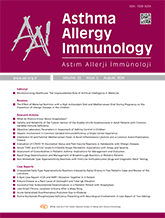


Kimura disease (KD) is a rare, chronic, inflammatory disorder of unknown etiology characterized by the development of subcutaneous lymphoid masses, usually in the head and neck region; regional lymphadenopathy; peripheral eosinophilia; and elevated levels of serum IgE. KD has been described in China and Japan as `eosinophilic hyperplastic lymphogranuloma` or `atypical granulation associated with hyperplastic abnormalities in the lymphoid tissue`. The precise prevalence and incidence and the pathogenesis of KD are unknown. Trauma, infection, an IgE-mediated hypersensitivity reaction, or autoimmune processes have been postulated as possible causes. In this article, we aimed to present a patient who was investigated with elevated serum total IgE and eosinophils and diagnosed as Kimura disease in the light of the current literature.